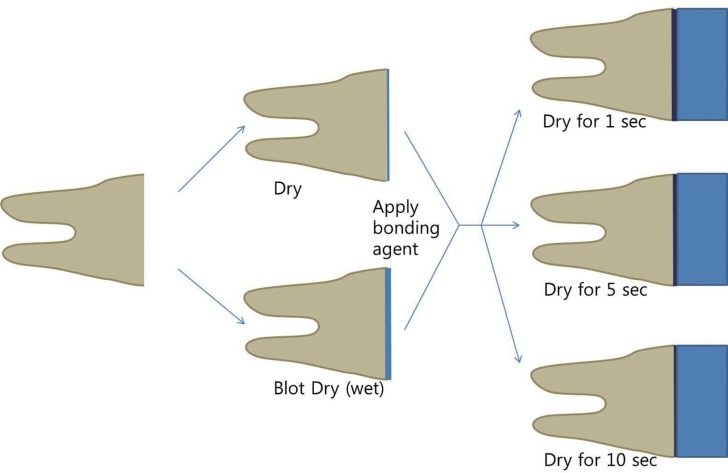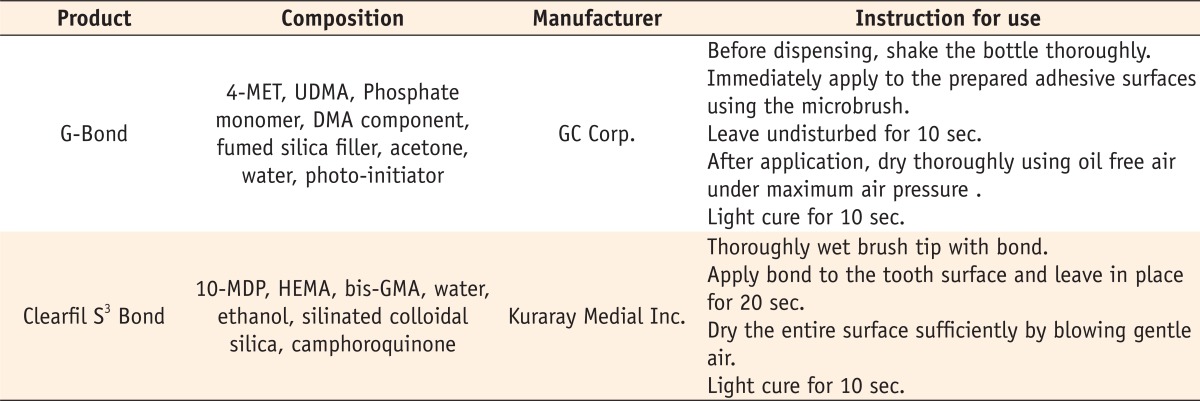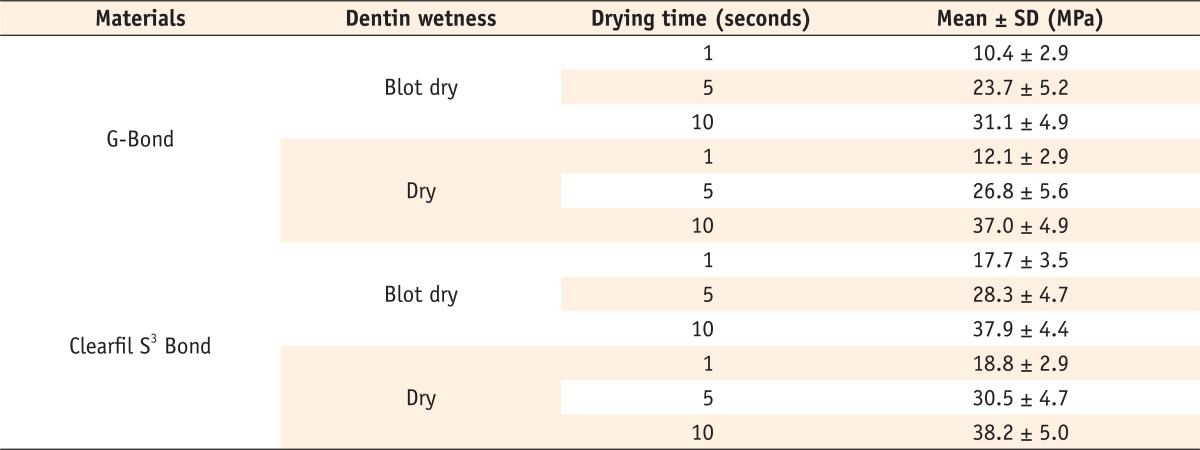1. Frankenberger R, Krämer N, Petschelt A. Technique sensitivity of dentin bonding: effect of application mistakes on bond strength and marginal adaptation. Oper Dent. 2000; 25:324–330. PMID:
11203838.
2. Soderholm KJ, Soares F, Argumosa M, Loveland C, Bimstein E, Guelmann M. Shear bond strength of one etch-and-rinse and five self-etching dental adhesives when used by six operators. Acta Odontol Scand. 2008; 66:243–249. PMID:
18615325.
3. Perdigão J. New developments in dental adhesion. Dent Clin North Am. 2007; 51:333–357. PMID:
17532916.

4. Van Landuyt KL, Mine A, De Munck J, Jaecques S, Peumans M, Lambrechts P, Van Meerbeek B. Are one-step adhesives easier to use and better performing? Multifactorial assessment of contemporary one-step self-etching adhesives. J Adhes Dent. 2009; 11:175–190. PMID:
19603581.
5. Van Meerbeek B, De Munck J, Yoshida Y, Inoue S, Vargas M, Vijay P, Van Landuyt K, Lambrechts P, Vanherle G. Buonocore memorial lecture. Adhesion to enamel and dentin: current status and future challenges. Oper Dent. 2003; 28:215–235. PMID:
12760693.
6. Yiu CK, Hiraishi N, King NM, Tay FR. Effect of dentinal surface preparation on bond strength of self-etching adhesives. J Adhes Dent. 2008; 10:173–182. PMID:
18652265.
7. Kitayama S, Nikaido T, Ikeda M, Foxton RM, Tagami J. Enamel bonding of self-etch and phosphoric acid-etch orthodontic adhesive systems. Dent Mater J. 2007; 26:135–143. PMID:
17410904.

8. Chiba Y, Rikuta A, Yasuda G, Yamamoto A, Takamizawa T, Kurokawa H, Ando S, Miyazaki M. Influence of moisture conditions on dentin bond strength of single-step self-etch adhesive systems. J Oral Sci. 2006; 48:131–137. PMID:
17023745.

9. Di Hipólito V, de Goes MF, Carrilho MR, Chan DC, Daronch M, Sinhoreti MA. SEM evaluation of contemporary self-etching primers applied to ground and unground enamel. J Adhes Dent. 2005; 7:203–211. PMID:
16240961.
10. Jin MU, Kim YK, Park JW. The influence of moisture control on bond strength of composite resin treated with self-etching adhesive system. J Korean Acad Conserv Dent. 2002; 27:363–369.

11. Werner JF, Tani C. Effect of relative humidity on bond strength of self-etching adhesives to dentin. J Adhes Dent. 2002; 4:277–282. PMID:
12666747.
12. Nakaoki Y, Sasakawa W, Horiuchi S, Nagano F, Ikeda T, Tanaka T, Inoue S, Uno S, Sano H, Sidhu SK. Effect of double-application of all-in-one adhesives on dentin bonding. J Dent. 2005; 33:765–772. PMID:
16199285.

13. Jacobsen T, Finger WJ, Kanehira M. Air-drying time of self-etching adhesives vs adhesive efficacy. J Adhes Dent. 2006; 8:387–392. PMID:
17243596.
14. Chiba Y, Yamaguchi K, Miyazaki M, Tsubota K, Takamizawa T, Moore BK. Effect of air-drying time of single-application self-etch adhesives on dentin bond strength. Oper Dent. 2006; 31:233–239. PMID:
16827027.

15. Van Landuyt KL, Snauwaert J, De Munck J, Coutinho E, Poitevin A, Yoshida Y, Suzuki K, Lambrechts P, Van Meerbeek B. Origin of interfacial droplets with one-step adhesives. J Dent Res. 2007; 86:739–744. PMID:
17652202.

16. Hiraishi N, Breschi L, Prati C, Ferrari M, Tagami J, King NM. Technique sensitivity associated with air-drying of HEMA-free, single-bottle, one-step self-etch adhesives. Dent Mater. 2007; 23:498–505. PMID:
16690113.

17. Van Landuyt KL, Snauwaert J, Peumans M, De Munck J, Lambrechts P, Van Meerbeek B. The role of HEMA in one-step self-etch adhesives. Dent Mater. 2008; 24:1412–1419. PMID:
18433860.

18. Tay FR, Gwinnett JA, Wei SH. Micromorphological spectrum from overdrying to overwetting acid-conditioned dentin in water-free acetone-based, single-bottle primer/adhesives. Dent Mater. 1996; 12:236–244. PMID:
9002841.

19. Tsuchimoto Y, Yoshida Y, Mine A, Nakamura M, Nishiyama N, Van Meerbeek B, Suzuki K, Kuboki T. Effect of 4-MET- and 10-MDP-based primers on resin adhesive to titanium. Dent Mater J. 2006; 25:120–124. PMID:
16706306.





 PDF
PDF ePub
ePub Citation
Citation Print
Print





 XML Download
XML Download